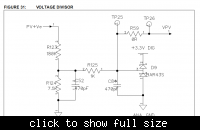sabu31
Advanced Member level 1

Hi
I wanted to design a voltage sensor for giving scaled down voltage input to adc of microcontroller dspic30f2020. I have refered microchip application notes (for dspic33f) and got a circuit (figure 1).
I have two queries. I am not able to understand the use of series resistor R125. Is it just to limit current to adc. Secondly how is the zener diodes functioning in this case as a supply of 3.3V is also given.
Secondly it was mentioned that source impedenced of adc (of dspic30f2020)should be less than 250ohms. So shouldnt R125 be less than 250 ohms.
I thought of modifying the circuit as shown. Would this work successfully? Also in the figure1 two grounds were given PV ground and ANalog ground. But should't bothe the grounds be same for sensing the voltage.
[adc can sense maximum of 5V, so zener is around 3.3 or 3.7V)


Thanks
I wanted to design a voltage sensor for giving scaled down voltage input to adc of microcontroller dspic30f2020. I have refered microchip application notes (for dspic33f) and got a circuit (figure 1).
I have two queries. I am not able to understand the use of series resistor R125. Is it just to limit current to adc. Secondly how is the zener diodes functioning in this case as a supply of 3.3V is also given.
Secondly it was mentioned that source impedenced of adc (of dspic30f2020)should be less than 250ohms. So shouldnt R125 be less than 250 ohms.
I thought of modifying the circuit as shown. Would this work successfully? Also in the figure1 two grounds were given PV ground and ANalog ground. But should't bothe the grounds be same for sensing the voltage.
[adc can sense maximum of 5V, so zener is around 3.3 or 3.7V)


Thanks

